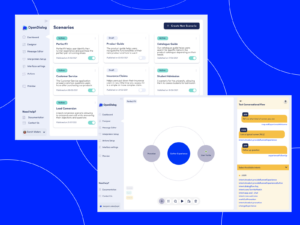The perfect mix
I have an academic background in linguistics, and after my studies I entered the world of User Experience (UX), designing and writing content for websites and mobile apps. When conversational AI became more mainstream, I saw it as a wonderful opportunity to ensure that people got access to relevant content in an easy, efficient manner.
Conversational UX is a perfect mix of everything I love – with aspects of linguistics, information architecture, content, and user centred design – and I’ve been specialising in this field over the past few years.
Putting the why in conversational AI
As conversational AI grows in popularity, there are more and more designers out there, and they often have different focuses. My philosophy is that conversational AI needs to work for the user and the business at the same time. With a conversational AI solution such as a chatbot, the end user should have a great experience, and achieve his or her desired outcome, and the business should meet its aims. You can build as many virtual agents as you want – but if the user is unable to complete their goal, not only will they be highly frustrated, but there will be no business impact. This is where conversational UX comes into play.
Because the technology is still in its early stages, we also have a unique opportunity with conversational AI to do things right from the get go when it comes to great design, user experience, and accessibility and inclusion. Whereas with other interface paradigms like web and mobile apps user design was very much an afterthought, with conversational AI it can be central to everything we do. It’s not the frosting on the cake, it’s in the mix from the beginning…
Three key trends for conversational UX
There are three key trends that I see in conversational UX at the moment, that I will really be focusing on in my role at GreenShoot Labs.
The first one is personalisation. Consumers across all sectors are now really set on having a personalised experience, and conversational AI is a great tool to facilitate this. Why? Well, for starters, conversation is highly personal by nature. We’ve been talking to each other for thousands of years, so words create connections between people better than anything else.
What’s more, when a user is looking for information, they want the answer to their particular question – not a generic answer they could find anywhere. This relevance is a key feature of conversational AI technology. So we need to find a way of leveraging data efficiently to provide personalised, desirable experiences.
This brings me on to the second conversational UX trend: privacy and security. In order to tailor an experience to a user, we need to know a certain amount of information about them. The more information we collect, the easier it might be to make an interaction highly personalised to them. But this convenience needs to be balanced against ethical considerations. Being user focused isn’t just saying this should be a nice experience for the user, it’s also about respecting their privacy. We’ve come to a point where there is more and more awareness around these issues, but there is still a lot of work to be done.
The third trend is around accessibility. This also ties into personalisation really, as it involves tailoring an experience to someone’s specific circumstances and challenges. Within conversational UX this raises questions around the technologies or vocabulary we might use, and the kind of persona we would give to a bot.
Generally in technology at the moment I see growing awareness around the importance of accessibility and inclusion, and conversational AI has a big role to play in making tech easier to use for people with diverse needs. Conversational AI itself should be inclusive, and we can leverage these tools to make other kinds of technology easier to use.
Forward thinking
I’m really happy to see conversational UX becoming more of a focus for designers and agencies. Rather than just building any old virtual agent, conversational UX ensures that agents are truly valuable for an organisation.
What does this look like in practice? Valuable conversations facilitated through conversational AI drive ROI and help meet business objectives, and they also give the user a fantastic experience. In order to achieve this, conversational UX is really important to obtain insight into business goals and what the user needs from their interaction.
This article was originally posted on the GreenShoot Labs website on 30th September 2020.



